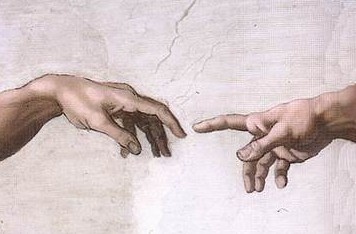
The Annunciation is perhaps the second most prolific topic in Renaissance paintings behind The Modonna and Child. It captures the scene when Angel Gabriel visits Mary and "announces" to her that she would give birth to the Son of God. Sandro Botticelli did multiple pieces on this topic. A lot of his paintings are located at the Galleria degli Uffizi in Florence, including this one. It is one of my favorites on this subject matter. It also appeared on the cover of the textbook we used that summer.

The clothing, particularly on Angel Gabriel, are drawn with remarkable skills. It's as if the angel had just made a sweeping landing into the room. I also just love his untucked wings. The folds on Gabriel's robe leads to his arm and hand, which in turn leads to Mary's. Gabriel's left hand is holding white lilies which symbolizes purity. Gabriel's mouth is slightly open, like he's about to deliver the sacre message: St. Luke's Gospel: "The Holy Ghost shall come upon thee, and the power of the Highest shall overshadow thee." Mary can be portrayed in five conditions in The Annunciation. Botticelli often prefers Conturbatio (or Disquiet), illustrating Mary as both astonished and amazed.
The use of perspective is strong in this piece. The tiles on the floor leads you to the distant background, which gives the picture a great sense of depth. The peculiar background with the strange architecture and landscape are indeed bizarre.
Two halves are seen: one with the angel with a bright background - fiat lux, the other with Mary in the darkness - coming into the light. The hands are the center of the picture and message: Annunciation and Acceptance.

Do they remind you of another famous pair of hands?
Hint...

No comments:
Post a Comment